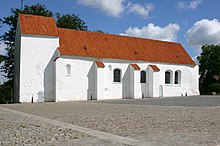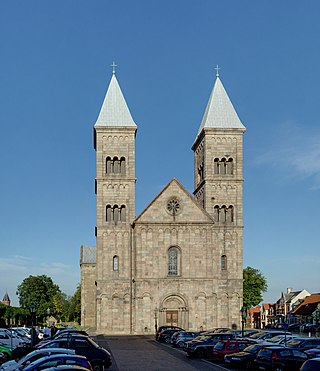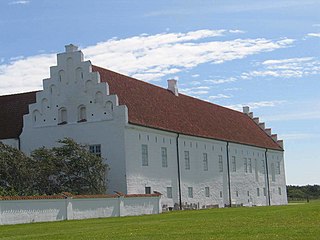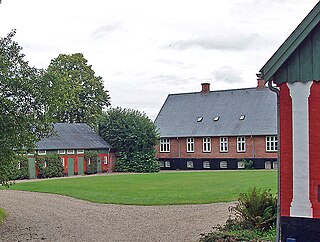
Asmild Abbey was a house of Augustinian canonesses with a close connection to the Augustinian canons at Viborg Cathedral in north central Jutland, Denmark from 1165 until reformation.

Asmild Abbey was a house of Augustinian canonesses with a close connection to the Augustinian canons at Viborg Cathedral in north central Jutland, Denmark from 1165 until reformation.
The relatively large church, which predated the nunnery, had its beginnings about 1090 as a parish church dedicated to Saint Margaret of Antioch during the reign of King Olaf I of Denmark, sometimes called Olaf Hunger. It functioned as the cathedral of Viborg until the new cathedral at Viborg was finished in 1133. It was constructed of granite and limestone in the Romanesque style with rounded arches and few windows. The church was of an irregular shape with a nave, one side-aisle with an apse, and a square choir also with an apse.
The most significant event in the history of the church was the murder of Bishop Eskild of Viborg in front of the main altar of the Asmild church in 1133. The murder according to the Roskilde Chronicle was to be laid directly at the feet of King Eric II of Denmark nicknamed Erik Emune of Denmark. Bishop Eskild was a supporter of King Niels of Denmark, who was defeated and killed in the Battle of Fodevig by Erik Emune in 1134.
Construction began on Asmild Abbey in 1165 just to the south of Asmild church, which was put at the disposal of the Augustinian nuns. The abbey consisted of three ranges and the church functioned as a disconnected north range, in a quadrilateral layout. The abbey was west of the bishop's residence (Danish:bispegård) as evidenced by the excavations done in the 1950s.
The work of the canonesses under the abbess of the abbey was in daily prayers and meditation and education of young women of noble birth. They were assisted in the day-to-day life by lay men and women who did much of the house and farm work required to keep the abbey going. It may be assumed that there was a small school on the premises, much like a religious boarding school. It is unclear whether the nuns at Asmild were regular or secular canonesses.
Expansion of the abbey in the 13th century changed the architectural style of parts of the building to Gothic with pointed windows and arches. Apparently, there was a fire which destroyed the 'old' cathedral and abbey in the mid-14th century. The church was replaced on a smaller scale. The abbey was rebuilt though on a smaller scale, perhaps because of the strictness of the rule, and the lack of income producing properties. Most abbeys maintained an archive of letters of gift (Danish: gavebrev) but Asmild's has been lost. There remains only a single 1346 letter offering a gift for continued prayers for a deceased relative. The abbey is last mentioned in a letter of 1461, and then nothing until the 1536 dissolution of the abbey.
The lack of information on the last decades of the abbey may be perhaps in part attributed to the local rumors about the immoral behavior of some of the nuns and Augustinian canons at the cathedral. Local tradition has it that a brick tunnel or walkway connected the abbey with the monastery near the cathedral, though no empirical evidence has been located that such a connection existed. If people lost confidence in the abbey's ability to keep a strict rule, no noble family would entrust a daughter or sister to the nuns at Asmild.
The Reformation brought about the end of Asmild Abbey when Denmark became a Lutheran state in October 1536. The nuns were permitted to live at the abbey until their death, though without income. The abbey estate came under crown control and Asmild was given to the former Bishop of Børglum, Stygge Krumpen (Rosencrantz) as an income property once he was released from prison. The buildings were turned into an estate farm called Asmild Kloster Farm which passed into private ownership in 1673. The abbey burned down in 1713, but was rebuilt. The buildings called Asmild Kloster became the property of Viborg County in 1906. In 1907 the buildings burned down except for one wing which survived but was eventually torn down in 1958. The only remnants of the abbey today are the stone-lined well, Asmild Church, and one of its bells, cast by an anonymous artist in the 15th century which still rings from the low bell tower.

The former Diocese of Aarhus was a Roman Catholic diocese in Denmark, founded in the 10th century and dissolved during the Protestant Reformation. The diocese included the counties of Aarhus and Randers, the islands of Samsø and Tunø, and, after 1396, part of the county of Viborg.

The former Diocese of Børglum was a Roman Catholic diocese in Northern Jutland, Denmark. It has also been referred to as the Diocese of Vestervig or the Bishopric of Vendsyssel. The diocese included Vendsyssel, Hanherred, Thy, and Mors.

Viborg Cathedral, Our Lady Cathedral is the site of one of Denmark's most important historic churches located in the town of Viborg in northern Jutland. The modern building is a 19th-century construction based on Lund Cathedral in southern Sweden which bears no resemblance to the medieval cathedral that stood on the site since 1130.

Børglum Abbey was an important Premonstratensian abbey of medieval Denmark, located in Børglum parish, in the commune of Hjørring, approximately five kilometers east of Løkken in north central Jutland from the 12th century until reformation.

Vitskøl Abbey is a former Cistercian monastery near Ranum in Himmerland in Region Nordjylland, Denmark, active from mid 12th-century until 1563, and one of the oldest existing monastic complexes in northern Europe.

Mariager Abbey was a Bridgettine abbey founded in 1430 which became an important pilgrimage site, in the present town of Mariager in northern central Jutland, Denmark.

Maribo Abbey, established in 1416, was the first Bridgettine monastery in Denmark and became one of the most important Danish abbeys of the late Middle Ages. It was located in the present town of Maribo on the island of Lolland in southern Denmark. The monastery is in ruins, but the abbey church still remains in use as Maribo Cathedral.

Vestervig Abbey, also known as Vestervig Church, was established in about 1059 making it one of Denmark's most ancient religious houses. The abbey is located at Vestervig, Thisted, in extreme northern Jutland.
Gudum Priory was a small Benedictine nunnery located in west central Jutland, Denmark from the 1260s until 1573.

The former Diocese of Viborg was a Roman Catholic diocese in Denmark. It was established in 1065 and was dissolved in 1536 during the Protestant Reformation.
Tvilum Priory was a monastery of Augustinian Canons at Tvilum near Gjern, to the north of Silkeborg, Denmark.

Ringsted Abbey was one of the earliest and most influential Benedictine houses in Denmark, active from the late 11th-century until the Danish Reformation. It was located at Ringsted on the Danish island of Zealand.

Æbelholt Abbey was an Augustinian monastery situated at Tjæreby in Hillerød municipality in North Zealand, Denmark.
St. Canute's Abbey, Odense, a Benedictine monastery, was built to support the pilgrimage centre for the relics of the royal Danish martyr Saint Canute, and was the successor to the priory of St. Mary and St. Alban, Denmark's earliest monastic house. Located in Odense, it was the island of Funen's most important medieval religious institution.
St. Peter's Priory was an early Augustinian monastery located between the towns of Grinderslev and Breum, in north central Denmark.

Vrejlev Priory is a former Danish priory which dates back to the 13th century. The priory located at Vrejlev, near Vrå, Region Nordjylland, Denmark. Between 1165 and the Protestant Reformation, it was operated as a Premonstratensian nunnery.
Slangerup Abbey was a nunnery first of Benedictine nuns, then of Cistercian nuns. It was in operation between 1170 and 1555 and was located in Slangerup, Denmark. It has left no visible remains.
Alling Abbey was one of the last Benedictine monasteries to be built in Denmark. Alling Kloster was located north of Silkeborg in the parish of Svostrup in Viborg County.

Voer Abbey was a Benedictine abbey in Voerladegård parish in Skanderborg Municipality, Denmark. It was situated on the Gudenå River near Klostermølle, site of the former monastery mill.